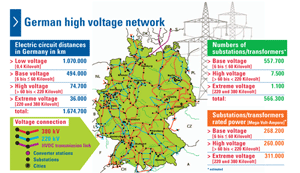Electrical power – too valuable to be wasted for driving?
"The electrification of vehicles is a key to sustainable and individual mobility of the future ..." (Original: Daimler AG). This is said and believed by many. In the "fine-print" will be promised somewhere later a: "... locally emission-free ..." (Original: BMW AG) mobility. But what does this mean? You need either electricity in order to charge batteries in vehicles (plug-in hybrid or all electric vehicles), or hydrogen, to transform it to electricity in vehicles (FC) or to burn it (H2ICE). Where will the long-term energy carrier come from? It is important to me, to support the opinion, that battery and hydrogen vehicles are a useful and necessary complement for sustainable mobility solutions.

With a length of 1,674,700 kilometers (1,000,000 miles) and 566,300 transformers in Germany alone, the existing electricity system is not necessarily meaningful. |
Let's start with the electricity
If we ask, where and how the electricity to operate “...a locally emission-free mobility” is created today, the answer is frightening: In 2006, more recent figures are not available, Germany needs for "his" electricity infrastructure a grid-network of 1,674,700 kilometers (1,000,000 miles) in length, including almost 75,000 kilometers (47,000 miles) medium-high-voltage transmission lines (> 60 to <220 kV) and 36,000 kilometers (23.000 miles) high-voltage lines (220 kV or 380 kV).
In order to get from the central places of electricity production in power plants to the consumers like industry, households, small and medium-sized businesses, commerce and transport, 566,300 transformers are humming along with 50 Hz. They transform not only the above mentioned voltages up and down to reach the socket, but above all, they create a lot of unused heat. This is currently now simply released into the atmosphere, to get rid of it. So they think anyway.
How did this infrastructure, which is not only at a second glance quite nonsensical and afflicted with many potential losses, could come into existence? The first electricity grids were island networks, ie, they initially served only to a small area around the prower plants of the electrical energy. This was particularly true for the first DC power plants, whose supply radius was for principle reasons restricted these days. The original use was for electric street or theatrical lighting systems.
Decentralized electricity supply first, then centrally
To increase the utilization of the “Centralen” (former name for power plants), also private homes were connected later. They were initially only reluctantly connected to the grid, because their course load was difficult to assess. In Munich, electricity was connected free of charge, if the house owner established the complete installation (electricity cellar, floor distributors etc.).
In 1882, Oskar von Miller was responsible for the first power transmission over 57 km (36 miles) from Miesbach to Munich in South germany. In 1891, he organized the International Electrical Exhibition in Frankfurt am Main. During this exhibition the first 20,000 V transmission over a 175 km (110 miles) long power line form Lauffen / Neckar to Frankfurt am Main was realized. At that time, the efficiency of the three-phase transmission was by 70%. This "good" efficiency of the three-phase transmission enabled to build large power plants instead of originally small and decentralized power plants and to operate them in combination.
From these beginnings evolved, over a period of almost 130 years, today's existing electrical infrastructure. In retrospect, a great achievement, but how should we proceed now? Can, may or should we leave everything as it is or can, may and should we put this infrastructure in question? The "little ..." Renewable Energy (RE) is not really helping as long as this electricity, produced by RE, is feeded by law into the grid, but then following the entire questionable "value chain" (see above) of the existing electricity infrastructure.
Let's now talk about hydrogen
This energy carrier is also well known, it is used industrially for decades. Operated since 1938, 220 km (138 miles) long, the Rhine-Ruhr pipeline system is the oldest hydrogen pipeline network. The U.S. are using currently many pipeline networks for hydrogen, so the 217 km (136 miles) hydrogen pipeline network Gulf-Coast/Texas, which is operated since 1969. Also in Canada, the Netherlands, Brazil and Thailand, these kind of networks are operational.
Some examples from Germany: In the center of the hydrogen application IGH2 community in the Chemical Park Knapsack in Huerth near Cologne, hydrogen is used since about 2005 for commercial energy use. The HyCologne - Hydrogen Rheinland e.V. region sees itself as a hydrogen-energy cluster. By combining of existing businesses and regional circumstances, this working group offers market opportunities for hydrogen and fuel cell technology.
However, on closer examination, this hydrogen is today (unfortunately) still not truly renewable, ie it is either a "waste product" from chloride-alkali chemicals or made from natural gas or it is produced by electrolysis. Where shall the new energy carrier come from in a real sustainable energy future? A notable proposal was given by the company H2Patent GmbH at the recent Hannover Fair.
Green and yellow hydrogen creates glowing perspectives
This company represents a new concept of energy production from renewable resources. Biomass shall be entirely transformed to highly pure (green) hydrogen as an ideal fuel for fuel cells. The central aim is to support the industrial production of hydrogen from biomass by a chemical process at high temperatures, the so called steam reforming. This process is now well developed, it delivers high-purity hydrogen with a high efficiency. As a home-produced energy carrier, this bio-hydrogen can compete with imported natural gas.
Also, the direct production of solar (yellow) hydrogen is promising, both processest require for green and yellow hydrogen a point-based, smart and forward-looking H2 infrastructure, though. This has not necessarily to be more expensive than modifying the current system, it can however be rather valuable in the long-term.
The market will decide, and hopefully we have enough time, to convince not just potential customers but also the politicians of truly sustainable renewable optimal solutions. Especially now with the upcoming redesign of our mobility to new energy carriers, we should remain critical. There is another little drop of bitterness: "General Electric" is, according to the German Automobile Club, ADAC breakdown statistics in 2008, with 40% by far the biggest cause of breakdown in ICE vehicles...
Photo caption: With a length of 1,674,700 kilometers (1,000,000 miles) and 566,300 transformers in Germany alone, the existing electricity system is not necessarily meaningful.
Graphics: Team Arno A. Evers FAIR-PR, Starnberg
Links to the news:
Date: 26.05.2009 |
